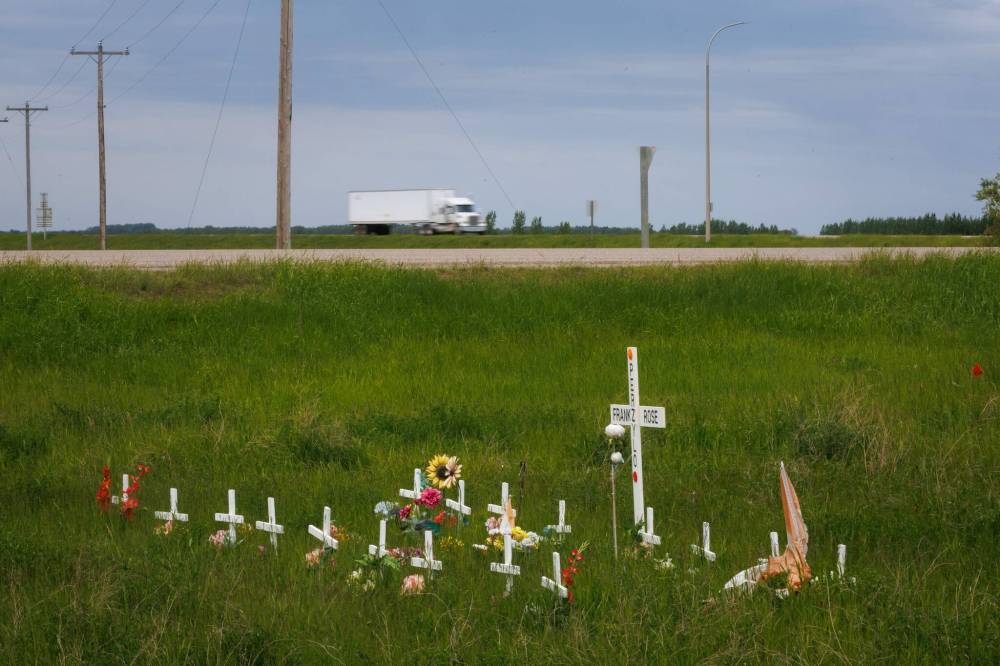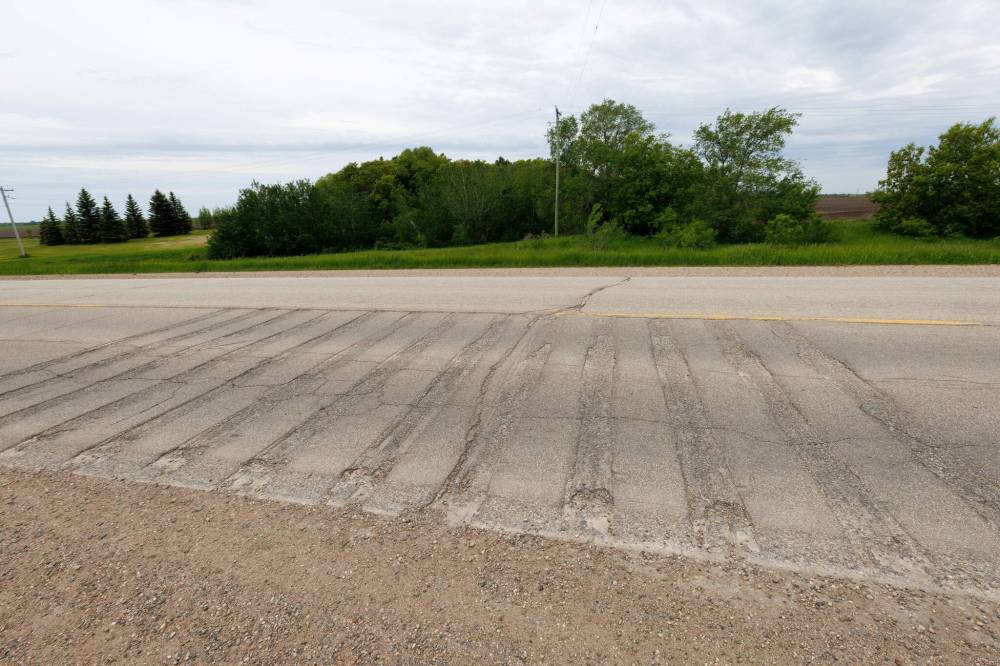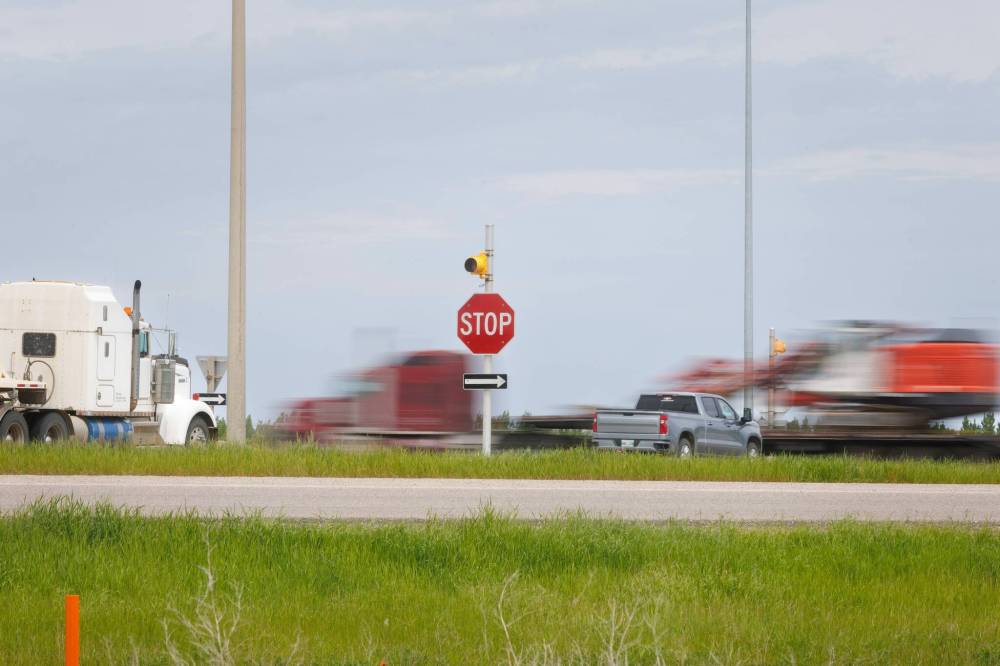CARBERRY — On the blacktop surface, not much has changed.
There are now flashing lights warning drivers of an “important intersection” ahead. The rumble strips for north-south traffic are more intense — avoid them if you’ve got a headache, locals warn. Planted in a nearby low-lying ditch are 17 small white crosses and one large one. And a charred patch of grass is still visible, just smaller now.
But the deadly intersection itself, where Highway 5 crosses the Trans-Canada in western Manitoba, remains unaltered.

MIKE DEAL / FREE PRESS
Seventeen small white crosses are planted in a nearby ditch.
It’s when you drive five minutes south that it becomes clear where the biggest change has occurred — strong currents of grief, anxiety and mental-health struggles swirl just below the surface.
The small rural town of Carberry was the closest community to the mass-casualty crash involving a semi-truck and a minibus at the intersection on June 15 last year. The bus was full of Dauphin-area seniors heading to a casino located a few kilometres south of town.
Fifteen people died that day and two later died in hospital.
When the eastbound semi slammed into the southbound minibus crossing the Trans-Canada, it became one of the deadliest road collisions in Canada’s history.
Dixie Friesen recalls that day vividly. The retired teacher remembers hearing the sirens and asking her husband, who was out working that day, what was going on.
“Someone said it was a bus accident,” he told her. “Humboldt bad.”
On April 6, 2018, 16 people were killed and 13 seriously injured when a northbound coach bus with the Humboldt Broncos junior hockey team, coaches and staff struck a westbound semi-trailer truck that blew through a stop sign near Armley, Sask. The driver of the semi-truck had failed to yield at a flashing stop sign
Friesen, who was planting flowers in garden boxes along Main Street, when the Free Press visited Carberry earlier this week, recalls worrying someone she knew, or a family member, was injured or killed. The sound of sirens today brings back stressful memories.

MIKE DEAL / FREE PRESS
New signs that alert drivers on Hwy 1 as they approach the intersection of Hwy 1 and Provincial Hwy 5 of an “important intersection” ahead.
“It’s always on your mind,” she said. “It was awful.”
She knows the pain must be worse for first responders.
Friesen’s brother, a Brandon firefighter who lives in Carberry, about a 40-minute drive, was called to the scene. When she saw him later that day, he seemed fine, she said. It wasn’t until days later when he realized he needed time to process what he’d been through.
“You don’t just move on from something like that,” Friesen said.
“You don’t just move on from something like that.”–Dixie Friesen
Grady Stephenson is the deputy fire chief with the Carberry North Cypress-Langford Fire Department. He was one of 13 volunteer firefighters from the department who responded to the crash.
He remembers getting paged that morning and thinking it was a standard two-vehicle collision, the kind his crew has responded to regularly at an intersection area residents had long known was dangerous. But as they approached the scene, he saw a plume of smoke. He knew it was serious.
“For me, it was chaos,” Stephenson said.
The scene was surreal, like out of a movie, he said. A bus was on fire, the crashed semi-truck was stretched across the road and there were dozens of people — bystanders desperately trying to help, and victims.
“It was the first time in 17 years as a first responder that I just kind of sat and looked out the window… to take that minute and recognize what we were up against,” he said. “It was overwhelming to start with, but then, as first responders, our training — everything starts to kick in and you get to work.”

MIKAELA MACKENZIE / FREE PRESS FILES
The scene of the collision between a minibus and semi-trailer on the Trans-Canada Highway north of Carberry on June 15, 2023.
Still, the day weighed on him.
In the wake of the crash, Stephenson’s mental health began deteriorating. He knew he needed help. He took a seven-week leave of absence from his job as the town’s chief administrative officer and a break from the fire department volunteer work. He was connected with a “phenomenal” counsellor and began taking prescribed medication for anxiety. It was difficult to step back from work, but necessary for his well-being and that of his team, he said.
Now, he shares his story to help others.
In April, he organized a mental-health awareness day at the high school with the help of the guidance counsellor, followed by an evening event for the community. There, he shared his mental-health journey, as did Chris Beaudry, the former Humboldt Broncos assistant coach who survived the crash. Stephenson also spoke at a recent Manitoba Association of Fire Chiefs event.
“I’m trying to be an open book about it,” he said. “I can’t say that I don’t want to talk about it and then tell people to talk about it.”
The conversations were long overdue.
Emma Seamone, a minister at Carberry United Church, said the catastrophic collision compounded the grief the tight-knit community of 1,800 people was already feeling.
In the preceding months, several people had died by suicide, including a young teen. Just two months prior to the bus crash, an 18-year-old girl from Carberry died in a car crash about 2 1/2 hours northwest in Gilbert Plains.
Seamone, who was out for a walk with her baby and stopped to talk to Friesen, said she is grateful for people like Stephenson for speaking out about mental health.
As if on cue, he happened to walk by just as she was praising his leadership.
“I think mental-health awareness is growing here,” Stephenson said, adding he hopes his work lessens stigma and also honours the memories of the seniors killed in the crash.
“None of us are ever going to forget June 15,” he said.
“None of us are ever going to forget June 15.”–Grady Stephenson
Carberry firefighters and other community members will travel to Dauphin Saturday to attend a memorial event for the 17 victims. There are also plans to build a permanent memorial in Carberry.
In January, the province committed $12 million to redesign the dangerous intersection after a third-party consultant’s report revealed a series of safety concerns.
There are three options for a redesign: widening the median located between the divided lanes of the Trans-Canada; installing a roundabout; or establishing an “RCUT” — which is also referred to as a J-turn — intersection that requires drivers to turn onto a main road and make a U-turn at a one-way median. Community consultations to discuss potential plans are set to begin later this month.

MIKE DEAL / FREE PRESS
Rumble strips on Provincial Hwy 5.
But reviews on the three options are mixed.
No one the Free Press spoke to in Carberry loved the idea of a roundabout or RCUT. They’re lukewarm on widening the median. They want want an overpass — which Pemier Wab Kinew said could one day be built but would cost upwards of $100 million — or a full set of traffic lights. The latter was not recommended in the consultant’s report.
“We need lights,” said Jen Anderson, while working at the gas station in town. “It’s either that or do an overpass.”

MIKE DEAL / FREE PRESS
The intersection, where Highway 5 crosses the Trans-Canada in western Manitoba, remains unaltered.
She worries a roundabout will just confuse drivers and be dangerous for trucks, especially in the winter.
It remains unclear when actual changes might come. A provincial spokesperson did not answer a question asking if the province is still on track to begin construction in 2025 and complete it by fall 2026, as stated in January. The spokesperson said a recommendation about a preferred layout is expected later this year with a final report expected in 2025.
In the meantime, residents have come up with their own strategies to stay safe. Some said they race across the four lanes of the Trans-Canada when there are gaps in both eastbound and westbound traffic, not willing to wait in the small median. Others avoid it entirely.
katrina.clarke@freepress.mb.ca

Katrina Clarke
Investigative reporter
Katrina Clarke is an investigative reporter at the Winnipeg Free Press. Katrina holds a bachelor’s degree in politics from Queen’s University and a master’s degree in journalism from Western University. She has worked at newspapers across Canada, including the National Post and the Toronto Star. She joined the Free Press in 2022. Read more about Katrina.
Every piece of reporting Katrina produces is reviewed by an editing team before it is posted online or published in print — part of the Free Press‘s tradition, since 1872, of producing reliable independent journalism. Read more about Free Press’s history and mandate, and learn how our newsroom operates.
Our newsroom depends on a growing audience of readers to power our journalism. If you are not a paid reader, please consider becoming a subscriber.
Our newsroom depends on its audience of readers to power our journalism. Thank you for your support.